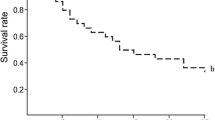Abstract
We determined the effects of number of prey and the area over which they were distributed on the number of prey eaten and the production efficiency ofMetasyrphus corollae (F.) (formelySyrphus corollae F.) larvae. We hypothesized that, for a given number of prey offered per day, increased plant size would reduce foraging efficiency and production efficiency. Also, increased prey number was expected to increase production efficiency. Individual larvae were offered 10, 20, 40 or 60 pea aphids each day on plants with 7.5, 35 or 73 cm2 surface area. When more aphids were offered, larvae ofM. corollae killed more of them but left larger aphid carcasses. Foraging efficiency (percentage of available aphids eaten) declined as aphid abundance and plant size increased. Foraging costs were not decreased by increasing prey density and therefore production efficiency was not increased.
Résumé
Les effets du nombre de proies et de la surface sur laquelle elles ont été distribuées, sur le nombre de proies mangées et sur le rendement de la production des larves deMetasyrphus corollae (F.) ont été déterminés. Nous avons supposé que, pour un nombre donné de proies offertes par jour, le rendement de la quête alimentaire et de la production diminueraient avec l'augmentation de la taille de la plante. De même, on supposait que le nombre croissant de proies augmentait le rendement de la production. On offrait chaque jour à des larves individuelles 10, 20, 40 ou 50 aphides du pois, sur des plantes dont la surface était 7,5, 35 ou 73 cm2. Quand on offrait plus d'aphides, les larves deM. corollae les tuaient, mais elles laissaient alors de plus gros cadavres. Le rendement de la quête alimentaire (pourcentage d'aphides disponibles mangés) diminuait lorsque l'abondance des aphides et la taille de la plante augmentaient. Les couts de la quête alimentaire n'étaient pas réduits par l'augmentation du nombre de proies et ainsi le rendement de la production n'était pas augmenté.
Similar content being viewed by others
References
Barlow, C. A. — 1979. Energy utilization by larvae of a flowerfly,Syrphus corollae [Diptera: Syrphidae]. —Can. Entomol., 111, 897–904.
Charnov, E. — 1976. Optimal foraging: the marginal value theorem. —Theoret. Pop. Biol., 9, 129–136.
Collins, N. C. — 1980. Developmental responses to food limitation as indicators of environmental conditions forEphydra cinerea Jones [Diptera]. —Ecology, 61, 650–661.
Cornelius, M. &Barlow, C. A. — 1980. Effect of aphid consumption on development and reproductive efficiency of a flowerfly,Syrphus corollae [Diptera: Syrphidae]. —Can. Entomol., 112, 989–992.
Corner, E. D. S., Head, R. N., Kilvington, C. C. &Pennycuick, L. — 1976. On the nutrition and metabolism of zooplankton. X. Quantitative aspects ofCalanus helgolandicus feeding as a carnivore. —J. Mar. Biol. Assoc. U. K., 56, 345–358.
Eveleigh, E. S. &Chant, D. A. — 1982. The searching behaviour of two species of phytoseiid mites.Phytoseilus persimilis Athias-Henriot andAmblyseius degenerans (Berlese), in relation to the density and distribution of prey in an homogeneous area [Acarina: Phytoseiidae]. —Can. J. Zool., 60, 648–658.
Giguère, L. A. — 1981. Food assimilation efficiency as a function of temperature and meal size in larvae ofChaoborus trivitatus [Diptera: Chaoboridae]. —J. Anim. Ecol., 50, 103–109.
Harrison, J. R. &Barlow, C. A. — 1972. Population growth of the pea aphid,Acyrthosiphon pisum [Homoptera: Aphididae] after exposure to extreme temperatures. —Ann. Entomol. Soc. Am., 65, 1011–1015.
Holling, C. S. — 1965. The functional response of predators to prey density and its role in mimicry and population regulation. —Mem. Entomol. Soc. Can., 45, 1–62.
Lawton, J. H. — 1970. Feeding and food energy assimilation in larvae of the damselflyPyrrhosoma nymphula (Sulz.) [Odonata: Zygoptera]. —J. Anim. Ecol., 39, 669–689.
Mathavan, S. &Muthukrishan, J. — 1976. Effects of ration levels and restriction of feeding durations on food utilization inDanaus chrysippus [Lepidoptera: Danaidae]. —Entomol. Exp. Appl., 24, 155–162.
Mukerji, M. J. &Guppy, J. C. — 1970. A quantitative study of food consumption and growth inPseudaletia unipuncta [Lepidoptera: Noctuidae]. —Can. Entomol., 102, 1179–1188.
Randolph, P. A., Randolph, J. C. &Barlow, C. A. — 1975. Age-specific energetics of the pea aphid,Acyrthosiphon pisum. —Ecology 56, 359–369.
Scott, S. M. &Barlow, C. A. — 1984. Effect of prey availability during development on the reproductive output ofMetasyrphus corollae [Diptera: Syrphidae]. —Environ. Entomol., 13, 669–674.
Sokal, R. R. &Rohlf, F. J. — 1969. Biometry: Principles and Practices of Statistics in Biological Research. —W. H. Freeman & Co., San Francisco. 776 pp.
Tanaka, K. &Itô, Y. — 1982. Different response in respiration between predaceous and phytophagous lady beetles [Coleoptera: Coccinellidae] to starvation. —Res. Popul. Ecol., 24, 132–141.
Author information
Authors and Affiliations
Rights and permissions
About this article
Cite this article
Scott, S.M., Barlow, C.A. Effect of prey availability on foraging and production efficiencies of larvalMetasyrphus corollae [Dipt.: Syrphidae] . Entomophaga 31, 243–250 (1986). https://doi.org/10.1007/BF02373333
Received:
Accepted:
Issue Date:
DOI: https://doi.org/10.1007/BF02373333



